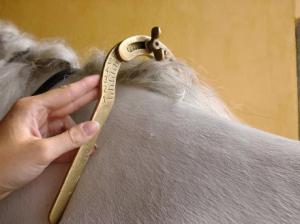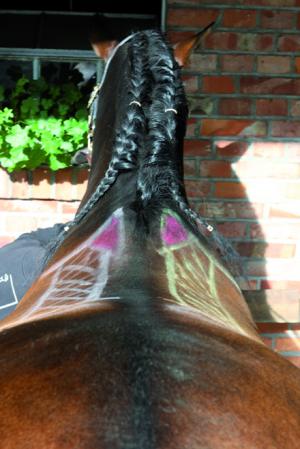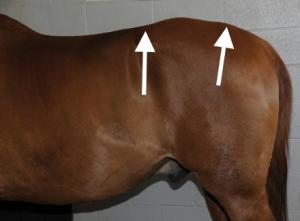By Jochen Schleese, CMS, CSFT, CSE
There are many opinions and theories on saddle fitting. Occasionally, we have even heard riders say “I have been using my saddle for x number of years. It fits me perfectly and fits every horse I use.” I really have to bite my tongue on that one, but usually just smile and say, “Lucky you.” However, if people are not educated on the facts about the effect of saddle fit on the horse’s back that have been substantiated in recent years through MRIs, thermography, and fibreoptic cameras, they do not realize the possible damage they are doing to themselves and their horses. Here I explain the two main theories on how to fit saddles properly, but there are probably several other variations on this theme.
Theory One
Many saddle manufacturers and their trained saddle fitters maintain that a saddle should have a narrow channel, therefore sitting on the spinal processes and ligaments. The tree is long and flat (resting on the shoulder and lumbar area) and sits with minimal weight bearing surface on the musculature. In this scenario, the saddle barely moves because it is sitting on the spine (other than perhaps to twist during motion as it is ‘kicked back’ by the bigger shoulder). This saddle rarely does need to be adjusted because bone structure and ligaments do not adapt and change their conformation through training like muscles do – and the muscles really won’t change much because the horse simply is not able to use his muscles properly with a saddle that fits like this. Often people will say “my saddle always fits” or “my saddle fits any horse.” They are semi-right, because one advantage to this is that they do not have to have a saddle fit or modified. The horse doesn’t really change.
The disadvantage with this is that the spine and ligaments will not tolerate prolonged compression and the horse’s back movement is restricted. To protect the shoulder, lumbar and spine, the horse will get tighter and tighter in its back (especially in the lumbar area), which leads to cramping in the gluteus maximus muscle. The horse will then develop a dip in front of its sacroiliac and the glutes will seize up. Between the sacroiliac joint and the tail, the gluteus will become atrophied (see hunter’s bump image). The front end of the horse will then push down the base of his neck and will ‘break’ over C3 in order to get on the bit. At this point it will become difficult for the rider to get the horse supple through the poll and have his highest point at the poll and not at C3.
Theory Two
In stark contrast, the other theory is for the saddle to stay off the spine, lumbar vertebrae, and shoulders – while maximizing the surface area the saddle sits on. The saddle support area is on the weight bearing longissimus dorsi (long back muscle). The advantage to having the saddle on the saddle support area muscle is to stay away from the reflex points that create negative behaviour or negative conformation and health issues. Staying off the spine, lumbar area, and shoulder keeps the back muscles loose and supple. Your horse can then articulate through the sacroiliac joint, and use his haunches better by stretching his gluteus maximus and hamstring. In theory one, where the saddle sits on the ligaments, involuntary contractions (i.e., cramping) impede correct coordination of muscle contractions and, thus, full range of motion is not possible. But, theory two allows for both stretching and contraction of the muscle (full range of motion). The most efficient way to train is to maximize both flexion (contraction) and extension (stretching), and in order to achieve this, full range of motion is required. By reducing the pressure on the shoulder, your horse will be able to lift the base of his neck and become supple through the poll. With theory number two, by allowing the horse to fully engage his muscles and lifting his rib cage, he will become more “uphill” and the balance of the saddle will need to be readdressed many times throughout his career as his positive changes are made in his conformation.
In theory number one, because the saddle is mainly sitting on the spine, with limited contact on the back muscle, the horse will continue going, but it will take a toll on his body. He will continue developing incorrect muscles and deformities will become more visible. Eventually, the atrophy in the back muscles and compression of the spine will lead to permanent damage. With theory number two, the increased range of motion will cause temporary soreness due to greater lactic acid build up (just like we have after using muscles during a new workout), which is nature’s way of recovering muscle fibre, but the result in the long run is greater muscle formation and increased circulation. During acute soreness, keeping pressure off the muscle would appear to be logical; however, the saddle needs to be supported somewhere.
If the horse has been in ill-fitting saddles in the past that have caused some back pain (as in theory one), don’t be discouraged if your horse shows signs of muscle soreness after switching to a saddle fitted according to theory two, as this is “good” muscle soreness (as mentioned above). You can temporarily help your horse by having the back of the saddle a bit looser (by loosening the V webbing back clip for instance). This will make the saddle move more in the back (up and down, not onto the spine!), and onlookers may misinterpret this as bouncing or an ill-fitting saddle. However, you will know, if you choose to go with the theory number two, that this is part of the process to help your horse. It will help him heal, get stronger, and develop correctly.
About the author:Jochen Schleese graduated from Passier as a Certified Master Saddler and came to Canada in 1986 to establish and register the trade of saddlery in North America, operating the only authorized saddlery training facility in Ontario. Schleese Saddlery Service is the world’s leading manufacturer of saddles designed for women, specializing in the unique anatomical requirements of female riders. Schleese authorized representatives provide diagnostic saddle fit analysis and saddle fitting services across North America to maintain optimal saddle fit to horse and rider. Saddlefit 4 Life educational programs and certification courses are held throughout North America, Europe, and Brazil.
www.Saddlesforwomen.com www.Saddlefit4life.com www.Schleese.com 800-225-2242
There are many opinions and theories on saddle fitting. Occasionally, we have even heard riders say “I have been using my saddle for x number of years. It fits me perfectly and fits every horse I use.” I really have to bite my tongue on that one, but usually just smile and say, “Lucky you.” However, if people are not educated on the facts about the effect of saddle fit on the horse’s back that have been substantiated in recent years through MRIs, thermography, and fibreoptic cameras, they do not realize the possible damage they are doing to themselves and their horses. Here I explain the two main theories on how to fit saddles properly, but there are probably several other variations on this theme.
Theory One
Many saddle manufacturers and their trained saddle fitters maintain that a saddle should have a narrow channel, therefore sitting on the spinal processes and ligaments. The tree is long and flat (resting on the shoulder and lumbar area) and sits with minimal weight bearing surface on the musculature. In this scenario, the saddle barely moves because it is sitting on the spine (other than perhaps to twist during motion as it is ‘kicked back’ by the bigger shoulder). This saddle rarely does need to be adjusted because bone structure and ligaments do not adapt and change their conformation through training like muscles do – and the muscles really won’t change much because the horse simply is not able to use his muscles properly with a saddle that fits like this. Often people will say “my saddle always fits” or “my saddle fits any horse.” They are semi-right, because one advantage to this is that they do not have to have a saddle fit or modified. The horse doesn’t really change.
The disadvantage with this is that the spine and ligaments will not tolerate prolonged compression and the horse’s back movement is restricted. To protect the shoulder, lumbar and spine, the horse will get tighter and tighter in its back (especially in the lumbar area), which leads to cramping in the gluteus maximus muscle. The horse will then develop a dip in front of its sacroiliac and the glutes will seize up. Between the sacroiliac joint and the tail, the gluteus will become atrophied (see hunter’s bump image). The front end of the horse will then push down the base of his neck and will ‘break’ over C3 in order to get on the bit. At this point it will become difficult for the rider to get the horse supple through the poll and have his highest point at the poll and not at C3.
Theory Two
In stark contrast, the other theory is for the saddle to stay off the spine, lumbar vertebrae, and shoulders – while maximizing the surface area the saddle sits on. The saddle support area is on the weight bearing longissimus dorsi (long back muscle). The advantage to having the saddle on the saddle support area muscle is to stay away from the reflex points that create negative behaviour or negative conformation and health issues. Staying off the spine, lumbar area, and shoulder keeps the back muscles loose and supple. Your horse can then articulate through the sacroiliac joint, and use his haunches better by stretching his gluteus maximus and hamstring. In theory one, where the saddle sits on the ligaments, involuntary contractions (i.e., cramping) impede correct coordination of muscle contractions and, thus, full range of motion is not possible. But, theory two allows for both stretching and contraction of the muscle (full range of motion). The most efficient way to train is to maximize both flexion (contraction) and extension (stretching), and in order to achieve this, full range of motion is required. By reducing the pressure on the shoulder, your horse will be able to lift the base of his neck and become supple through the poll. With theory number two, by allowing the horse to fully engage his muscles and lifting his rib cage, he will become more “uphill” and the balance of the saddle will need to be readdressed many times throughout his career as his positive changes are made in his conformation.
In theory number one, because the saddle is mainly sitting on the spine, with limited contact on the back muscle, the horse will continue going, but it will take a toll on his body. He will continue developing incorrect muscles and deformities will become more visible. Eventually, the atrophy in the back muscles and compression of the spine will lead to permanent damage. With theory number two, the increased range of motion will cause temporary soreness due to greater lactic acid build up (just like we have after using muscles during a new workout), which is nature’s way of recovering muscle fibre, but the result in the long run is greater muscle formation and increased circulation. During acute soreness, keeping pressure off the muscle would appear to be logical; however, the saddle needs to be supported somewhere.
If the horse has been in ill-fitting saddles in the past that have caused some back pain (as in theory one), don’t be discouraged if your horse shows signs of muscle soreness after switching to a saddle fitted according to theory two, as this is “good” muscle soreness (as mentioned above). You can temporarily help your horse by having the back of the saddle a bit looser (by loosening the V webbing back clip for instance). This will make the saddle move more in the back (up and down, not onto the spine!), and onlookers may misinterpret this as bouncing or an ill-fitting saddle. However, you will know, if you choose to go with the theory number two, that this is part of the process to help your horse. It will help him heal, get stronger, and develop correctly.
About the author:Jochen Schleese graduated from Passier as a Certified Master Saddler and came to Canada in 1986 to establish and register the trade of saddlery in North America, operating the only authorized saddlery training facility in Ontario. Schleese Saddlery Service is the world’s leading manufacturer of saddles designed for women, specializing in the unique anatomical requirements of female riders. Schleese authorized representatives provide diagnostic saddle fit analysis and saddle fitting services across North America to maintain optimal saddle fit to horse and rider. Saddlefit 4 Life educational programs and certification courses are held throughout North America, Europe, and Brazil.
www.Saddlesforwomen.com www.Saddlefit4life.com www.Schleese.com 800-225-2242










